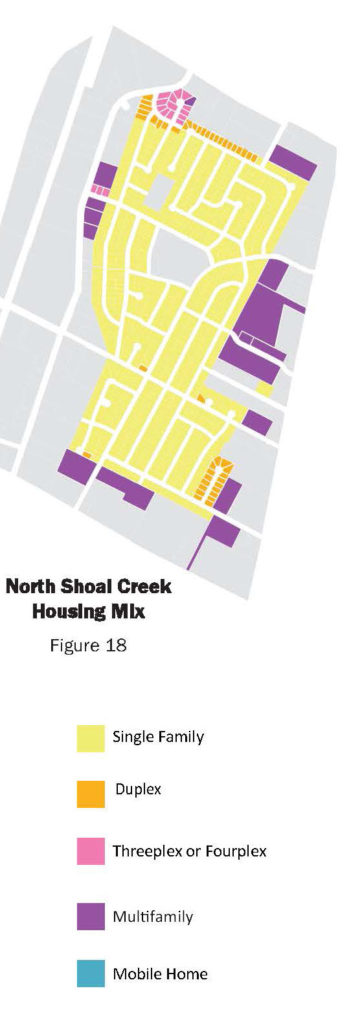-
The “School News” article on page 9 of our Fall/Sept. 2019 newsletter said that “One option being considered to solve the problem of morning and afternoon traffic jams on Crosscreek is to make Crosscreek one-way going east.” Pillow Elementary School principal Yvette Cardenas reports that is NOT an option Pillow is considering. The article also asked that feedback on the possibility be sent to safety@nscna.org. The feedback we received was uniformly negative. To those who sent feedback, thank you. And if you’ve been worried about the possibility of Crosscreek becoming one-way, you can stop worrying about that now.
-
MU5A: High-intensity multi-use residential, office, service, retail, and entertainment uses
MU5B: high intensity residential & commercial, including storage and auto-related businesses
- Minimum lot size: 5,000 sq. ft. if multifamily; 48 dwelling units/acre + unlimited AHBP (Affordable Housing Bonus Program)
- Minimum lot size: 1,800 sq. ft. live/work or townhouse; 24 dwelling units/acre; no AHBP
- Setbacks from property lines: 5’ front – 5’ side street – 0’ side-0’ rear
- Compatibility setbacks <75’ wide lot: 5-5-15-30
- >75’ wide lot: 5-5-20-30
- Height max. : 60‘ + 30’ AHBP = up to 90’ total with AHBP
- Stepbacks: <25’ = 25’
- 25-50 = 35’
- Impervious cover: 90%
MS3: high intensity urban main street environment
- Minimum lot size: 1,800 sq. ft.
- Number of dwelling units: if multi-family, then 54 dwelling units/acre + unlimited AHBP
- If live/work or townhouse, then 24 base units/acre; no bonus units under AHBP
- Setbacks from property lines: 5’ -5’- 0’- 0’
- Height max: 65’ + 25’ AHBP = 90’ total with AHBP
- Compatibility setbacks <75’ wide lot: 10-10-15-30
- >75’ wide lot: 10-10-20-30
- Stepbacks: <25’ = 25’
- 25-50’ = 35’
- 50-100’ = 45’
- Impervious cover: 95%
IF Flex Industrial
- Minimum 5,000 sq. ft. lot with a minimum 50’ width can contain up to 24 dwelling units/acre
- Setbacks from property lines: 15–10-10-10
- Compatibility setbacks: <75’ lot: 15-10-15-30
- >75’ lot: 15-10-30-30
- Maximum height: 60’
- Stepbacks: <50’: 35’ and 45’ at 50-100’
IG General Industrial
- Minimum lot size of 1 acre with a minimum width of 100’
- Dwelling units not allowed
- Setbacks: 25-25-10-10
- Compatibility setbacks: <75’: 25-25-15-50
- >75’: 25-25-50-50
- Maximum height: 60’
- Stepbacks: <50’: 35’ and 45’ at 50-100’
Impervious cover maximum for both IF and IG: 80%
Both IF and IG require a landscape buffer along the side or rear lot as per Section 23-3D-3080.
For parking requirements in IF and IG, please see Section 23-3C-8040.
-
North Shoal Creek is zoned to contain 3 of the 5 zoning codes proposed for multifamily areas in the draft LDC. Please see the map below for the locations of our neighborhood’s multifamily zones.
RM2 (the triplexes and fourplexes on Mossrock & Dawnridge Circle):
- Min. lot size for a multifamily dwelling: 5,000 sq. ft.
- Min. lot size for a live/work dwelling or townhouse: 1,800 sq. ft.
- Number of dwelling units per acre: 24 base, with an additional 36/acre under AHBP
- Setbacks from property line: 10’ front-5’ side street-5’ side-5’ rear
- Compatibility setbacks <75’ wide lot: 10’-5’-15’-30’
- >75’ wide lot: 10’-5’-20’-30’
- Overall max. width of bldg.: 100’
- Maximum height : 40‘ + 20’ AHBP (total of 60’ with AHBP)
- Stepbacks: <25’ = 25’
- 25-50 = 35’
- 50-100 = 45’
- Impervious cover: 60%
RM3 (all other existing multifamily apartments and condos in North Shoal Creek)
- Min. lot size for a multifamily dwelling: 5,000 sq. ft.
- Min. lot size for a live/work unit or townhouse: 1,800 sq. ft.
- Number of dwelling units per acre: 36 base, with an additional 40/acre under AHBP
- If live/work or townhouse: 24 units/acre base; AHBP not available
- Setbacks from property line: 5’ – 5’- 5’- 5’
- Compatibility setbacks <75’ wide lot: 5’-5’-10’-30’
- >75’ wide lot: 5’-5’-20’-30’
- Maximum height: 60′ + 30’ AHBP (total of 90’ with AHBP)
- Stepbacks: <25’ = 25’
- 25-50 = 35’
- 50-100 = 45’
- Impervious cover: 70%
RM5 (the 300-unit complex to be constructed near the corner of Rockwood and Burnet)
- Min. lot size for a multifamily dwelling: 5,000 sq. ft.
- Min. lot size for a live/work dwelling or townhouse: 1,800 sq. ft.
- Number of dwelling units/acre: 54 base; unlimited if under AHBP
- If live/work or townhouse: 24 base with no AHBP available
- Setbacks from property line: 5’- 5’- 5’- 5’
- Height max: 90’ + 30’ AHBP (total of 120’ with AHBP)
- Compatibility setbacks <75’ wide lot: 5′-5′-10′-30′
- >75’ wide lot: 5′-5′-20′-30′
- Stepbacks: < 50 = 35’; 50-100 = 45’
- Impervious cover: 80%
-
Existing single family zoning in North Shoal Creek becomes R2A zoning, with this exception: single-family houses along Rockwood between Steck and Anderson become R4. R4 is the least-intense missing middle zone in a transition area.
What can be built in an R2A zone? A maximum of 2 dwelling units, although a home qualifying for a preservation incentive could build a total of 3 units
- On a 5,000 sq. ft. lot: 1 single-family home, a duplex, or a single-family home with an ADU (Accessory Dwelling Unit)
- On a 2,500 sq. ft. lot: 1 single-family attached home
- Setbacks from property line: 25’ front, 15’ side street, 5’ side, 10’ rear
- Overall height: 35’
- Allowable impervious cover: 45% if lot width is greater than 45’; 50% if less than 45’
- Off street parking: 1 space/dwelling unit. No parking requirement for an ADU.
- Maximum height of a dwelling within 10’ of property line: 30’
What isn’t allowed in R2A? Co-housing, cottage courts, group residential, multi-family homes, Type 3 short term rentals, townhomes, and stables.
What isn’t allowed in R4? New single family or single-family attached homes and stables. However, existing single-family homes can be maintained in perpetuity and expanded or rebuilt. Only if a single-family home were expanded to include multiple units would the right to resume single-family use of a property be lost.
What can be built in an R4 zone? A maximum of 4 dwelling units with 4 additional units (for a total of 8) allowed under the AHBP (Affordable Housing Bonus Program)
- On a 10,000 sq. ft. lot with a minimum 90’ width: 6 unit cottage court; AHBP doesn’t apply.
- On a 5,000 sq. ft. lot: A duplex or a multi-family unit up to a maximum of 4 units, with 4 additional units allowed under the AHBP
- On a 1,800 sq. ft. lot with a minimum 18’ width: a townhouse
- Setbacks: 15’ front, 10’ side street, 5’ side, 5’ rear
- Building maximum width: 80’
- Overall height: 35’ + 10’ (total 45’) under the AHBP.
- Allowable impervious cover: 50%
-
Planning Commission
Community Interest Announcement
Land Development Code Revision Working Groups Workshop Monday, October 14, 2019 at 6-9:00 p.m.
Austin City Hall
301 W. 2nd Street, Austin, Texas
Planning Commission Working Groups invite the public to participate in discussion regarding the Land Development Code Revision.
6:00 p.m.
Affordability Working Group – City Hall, Atrium Downtown Working Group – City Hall, W. 2nd Street Entrance Lounge
Process / Admin Procedures Working Group– City Hall, Room 2003
7:30 p.m.
Residential Working Group – City Hall, Atrium
Non-Residential Zones Working Group – City Hall, W. 2nd Street Entrance Lounge Transition Zones Working Group – City Hall, Room 2003
For more info, contact Commission Liaison – Andrew Rivera 512-974-6508







